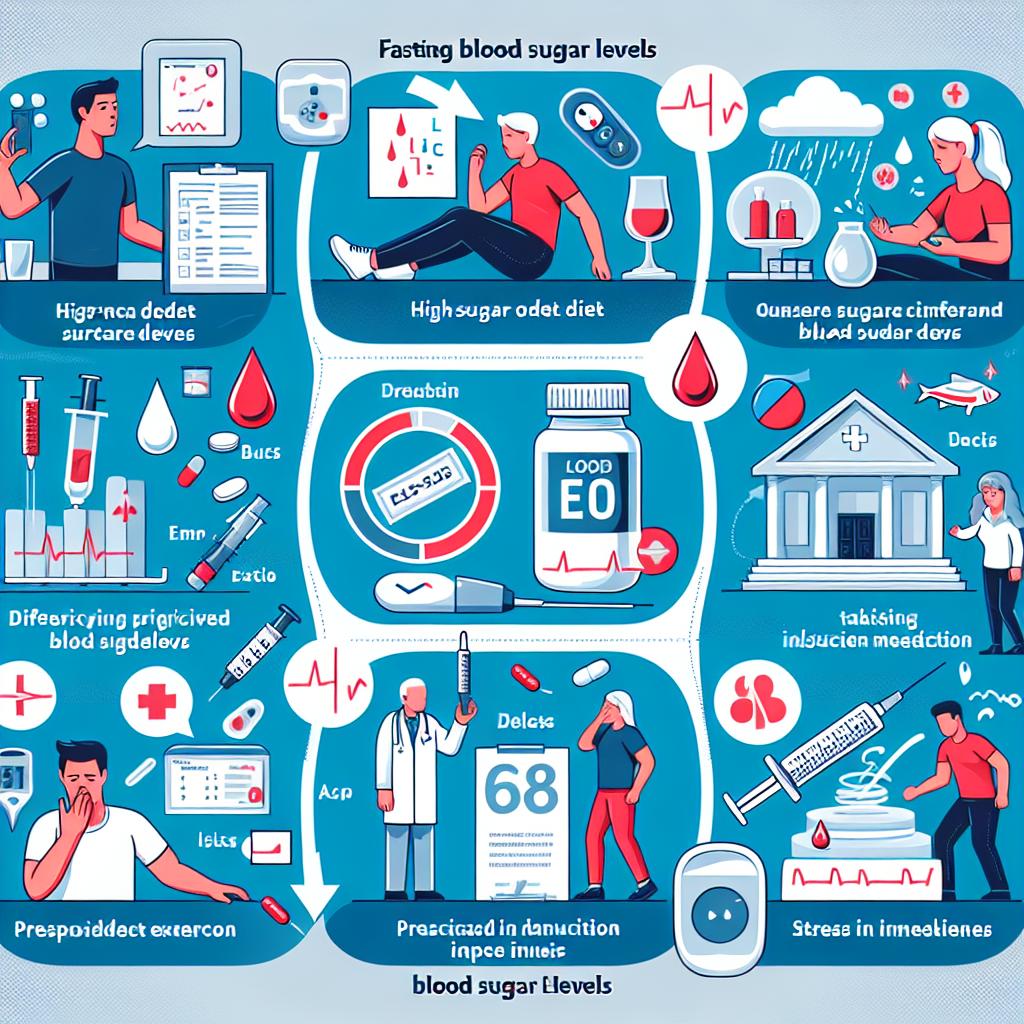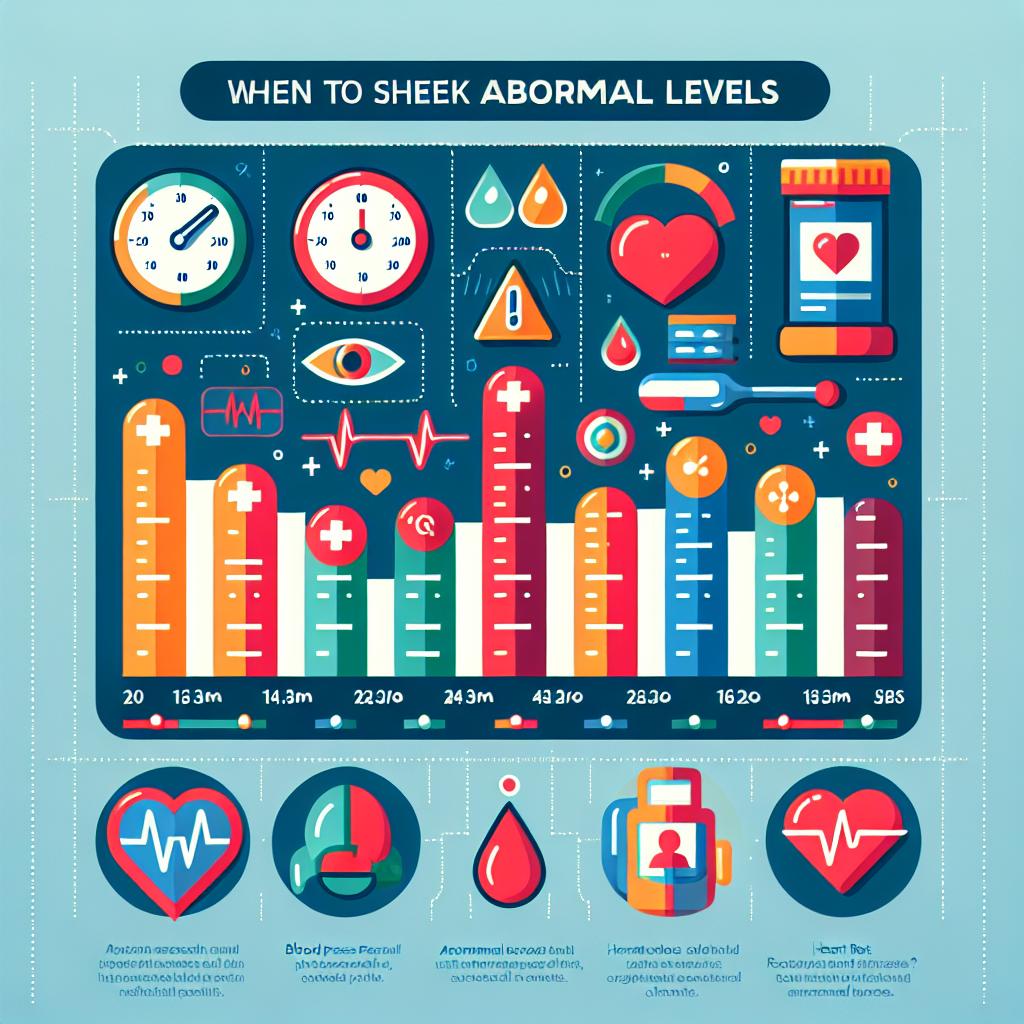
“Optimal Levels: Where Should Fasting Blood Sugar Be?”
Navigating the intricacies of our body’s glucose management is no small feat, particularly when it pertains to the critical measurement of fasting blood sugar levels. As a vital marker of our metabolic health, understanding the optimal thresholds for fasting blood sugar has implications that span far beyond the morning test ritual. Scientists and medical professionals have long debated the numerical sweet spot that balances the body’s needs with the avoidance of long-term health complications. In this deep-dive exploration, we will sift through the latest research, examine the nuances of glucose regulation, and unveil the expert consensus on where our fasting blood sugar should ideally be to maintain health and vitality. Understanding these numbers is not just a matter for those with diabetes or pre-diabetes; it is a cornerstone of preventative health care for everyone. Join us as we unravel the data that helps chart a course toward optimal wellness.
Table of Contents
- Understanding Fasting Blood Sugar and Its Importance
- The Goldilocks Zone: Ideal Fasting Blood Sugar Ranges
- Factors That Influence Fasting Blood Sugar Levels
- Interpreting Your Fasting Blood Sugar Results
- When to Seek Medical Advice: Recognizing Abnormal Levels
- Lifestyle Modifications for Maintaining Healthy Blood Sugar
- The Role of Diet in Controlling Fasting Blood Sugar
- Exercise and Its Impact on Blood Sugar Balance
- Monitoring and Adjusting: The Path to Optimal Fasting Blood Sugar
- Emerging Research and Future Directions in Blood Sugar Management
- Q&A
- Concluding Remarks
Understanding Fasting Blood Sugar and Its Importance

Delving into the world of glucose management, the fasting blood sugar level is a critical indicator of metabolic health, scrutinized closely by healthcare professionals and patients alike. It refers to the concentration of sugar, or glucose, in the blood after an overnight fast, providing insight into how well the body regulates blood sugar levels without recent food intake interference.
Why is monitoring fasting blood sugar so pivotal? For starters, it’s a cornerstone in diagnosing conditions such as diabetes and prediabetes. Regular tracking can alert individuals to potential health issues, enabling early intervention and thereby reducing the risk of complications associated with high blood sugar levels, such as nerve damage, kidney disease, and cardiovascular issues. Moreover, it serves as a gauge for how effectively current treatments or lifestyle modifications are managing blood glucose.
Optimal fasting blood sugar levels typically fall within a certain range. The American Diabetes Association (ADA) suggests the following guidelines:
- Normal: Less than 100 mg/dL
- Prediabetes: 100 to 125 mg/dL
- Diabetes: 126 mg/dL or higher
To facilitate a clearer understanding, let’s visualize these ranges with a simple, easy-to-read table:
| Status | Fasting Blood Sugar Level (mg/dL) |
|---|---|
| Normal | Less than 100 |
| Prediabetes | 100 to 125 |
| Diabetes | 126 or higher |
It’s vital, however, to remember that individual targets may vary, especially for those with diabetes, where factors such as age, comorbid conditions, and personal health goals play a role. Continually consulting with a healthcare provider ensures personalized and adaptive management strategies, tailored to one’s unique health profile.
The Goldilocks Zone: Ideal Fasting Blood Sugar Ranges

Navigating through the numbers associated with fasting blood sugar can be akin to finding the sweet spot in a spectrum of possibilities—a place where the levels are “just right.” Health professionals often use the term “euglycemia” to describe this ideal state, where the blood sugar is neither too high (hyperglycemia) nor too low (hypoglycemia).
Understanding the Numbers
Before delving into the nuances of fasting blood sugar, it’s vital to comprehend what the numbers mean. Fasting blood sugar, or glucose, is the concentration of sugar in your blood after an overnight fast. It’s a critical indicator of your body’s ability to regulate glucose and can indicate potential health issues, such as prediabetes or diabetes, when outside the normal range.
- Normal Range: Typically ranges from 70 to 99 milligrams per deciliter (mg/dL)
- Prediabetes Range: Between 100 to 125 mg/dL
- Diabetes Range: 126 mg/dL or higher on two separate tests
Clinicians often aim for patients to maintain levels within the normal range to promote overall health and prevent the long-term complications associated with diabetes. However, the target can vary depending on individual health profiles.
Customizing Your Target
Personal health factors can shift the ideal fasting blood sugar target. Variables like age, health history, and the presence of other medical conditions can affect the ideal range. Therefore, it is essential to consult with your healthcare provider to determine the target that is best for you.
| Age Group | General Fasting Blood Sugar Target (mg/dL) |
|---|---|
| Adults under 60 | 70-99 |
| Adults 60-80 | 80-130 |
| Adults over 80 | Target may be adjusted higher based on health conditions |
Maintaining the Balance
Striving to maintain fasting blood sugar within the desirable range is a balancing act involving diet, exercise, and sometimes medication. Regular monitoring and lifestyle adjustments can lead to substantial improvements for those at risk or managing diabetes. Develop mindfulness of sugar intake, engage in regular physical activity, and adhere to medical advice to stay within your ideal fasting blood sugar zone—your personal Goldilocks range.
Factors That Influence Fasting Blood Sugar Levels

Waking up to a new day offers more than just a fresh start; it’s also the perfect time to assess one of the critical barometers of health — your fasting blood sugar level. This measurement isn’t influenced just by what you ate the night before, but by a tapestry of interconnected factors.
Dietary Choices play a decisive role in determining glucose levels. A dinner high in refined sugars or carbohydrates can cause an overnight spike, leading to elevated readings in the morning. It’s not only the type of food but also the timing; eating close to bedtime doesn’t allow insulin adequate time to metabolize the sugars effectively before the fasting period begins.
- Refined sugars
- Carbohydrates
- Meal timing
Physical Activity is another significant influencer. Both the presence and absence of exercise have a direct impact. Regular exercise helps in maintaining insulin sensitivity, allowing your body to utilize glucose efficiently. Conversely, a sedentary lifestyle might lead to higher fasting levels as the body’s glucose regulation becomes less effective over time.
Stress and Sleep are often overlooked but potent modulators. Cortisol, the stress hormone, can increase glucose production in the liver, thwarting efforts to keep blood sugar low. Similarly, a restful night’s sleep is essential; disruption of the sleep cycle can lead to insulin resistance, inadvertently upping morning glucose levels.
| Health Condition | Effect on Blood Sugar |
|---|---|
| Type 2 Diabetes | Chronic high levels |
| Hypothyroidism | Increases resistance to insulin |
| Polycystic Ovary Syndrome (PCOS) | May elevate fasting glucose |
| Pancreatic function | Impaired insulin production |
Finally, understanding Health Conditions and Medications that affect glucose levels is critical. Conditions like diabetes or hypothyroidism have a pronounced influence, but even common over-the-counter medications can alter readings. Be sure to discuss these factors with your healthcare provider to understand their potential impact on your morning blood sugar.
Interpreting Your Fasting Blood Sugar Results

Waking up in the morning and getting your fasting blood sugar levels checked is like peeking at the dashboard of your health vehicle before hitting the road. It’s your body’s way of presenting a snapshot of how well your fuel processing system – also known as your metabolism – is functioning after a period of fasting, usually overnight. But when the numbers flash on the glucometer’s screen, understanding what they signify can be as puzzling as interpreting a foreign film with no subtitles. However, fear not – we’ll demystify these digits and tell you what they’re whispering about your health.
Normal Ranges and What They Mean
- Below 70 mg/dL: Your levels are considered low, potentially indicative of hypoglycemia.
- 70 to 99 mg/dL: This is the sweet spot, reflecting optimal fasting blood sugar levels.
- 100 to 125 mg/dL: These numbers point toward prediabetes, a nudge from your body to take corrective measures.
- Above 126 mg/dL: This range may signal diabetes and warrants further investigation and possible intervention.
Your results are more than just numbers; they’re the outcome of the intricate dance between your insulin and glucose through the night. A fasting blood sugar level that rests comfortably in the optimal range is a sign that your metabolic harmony is pitch-perfect. On the contrary, numbers oscillating away from this range can be the early beats of a rhythm that requires tuning – an insight that’s priceless for maintaining wellness or averting chronic conditions.
| Category | Fasting Blood Sugar Levels (mg/dL) | Risk-Level |
|---|---|---|
| Low | Below 70 | Potential Hypoglycemia |
| Normal | 70-99 | Optimal |
| Prediabetes | 100-125 | Moderate Risk |
| Diabetes | 126 and above | High Risk |
Unraveling these readings is crucial, since they can be a beacon that guides your dietary and lifestyle choices. For instance, someone floating in the optimal range might continue their balanced diet and regular physical activity, while a more elevated reading could nudge one towards a consult with a healthcare professional for a tailored health plan. Remember, the goal is to maintain or pivot back to that metabolic equilibrium—where fasting blood sugar levels are less a warning signal, and more a badge of good health.
When to Seek Medical Advice: Recognizing Abnormal Levels

Understanding your fasting blood sugar levels is crucial for maintaining optimal health and detecting potential health issues early. Your body’s fasting blood glucose concentration can signal whether your glucose regulation is within a healthy range or if there may be underlying health concerns. It’s essential to know when fluctuations in your blood sugar readings warrant a consultation with a healthcare professional.
- Persistent Hyperglycemia: If you consistently record fasting blood sugar readings above 126 mg/dL, it can indicate diabetes or pre-diabetes. Chronic high levels can lead to serious health complications, making it imperative to seek medical counsel.
- Unexpected Variability: Fluctuations in blood sugar levels beyond the expected range, especially if you are managing diabetes, may suggest that your current management strategy needs adjustment.
- Hypoglycemia: Readings lower than 70 mg/dL while fasting are considered low and can be as dangerous as high levels. If you encounter symptoms like dizziness, sweating, or confusion along with low readings, it’s time to consult a doctor.
Alongside numerical readings, paying attention to your body’s signals is also a reliable barometer for seeking advice. Symptoms such as excessive thirst, frequent urination, unexplained weight loss, or a persistent sense of fatigue should trigger a health professional’s visit, irrespective of your numerical blood sugar measurements.
Below is a simplified reference table to guide you on standard fasting blood glucose levels:
| Condition | Fasting Blood Sugar Level (mg/dL) |
|---|---|
| Normal | 70-99 |
| Pre-diabetes | 100-125 |
| Diabetes | 126 and above |
It’s important to note that one-off readings should not cause undue concern; however, a pattern of abnormal levels or symptomatic experiences must not be disregarded. Always consult with a healthcare professional for personalized advice and consider any lifestyle changes or medical interventions they may recommend. Managing your fasting blood sugar levels is not just about numbers but also about ensuring your overall well-being.
Lifestyle Modifications for Maintaining Healthy Blood Sugar

The journey to maintaining healthy fasting blood sugar levels often starts at the dinner table and extends to our daily routines. A strategic approach to diet and exercise can work wonders in stabilizing glucose readings. Focus on fiber-rich foods such as fruits, vegetables, whole grains, and legumes. They slow down the digestion of carbohydrates, causing a more gradual release of glucose into the bloodstream.
Moreover, integrating regular physical activity into your life is crucial. Exercise increases insulin sensitivity, meaning your body will require less insulin to transport sugar to your cells. A combination of both aerobic exercises, like walking or swimming, and resistance training, like weight lifting, has proven to be the most beneficial. Aim for at least 150 minutes of moderate aerobic activity or 75 minutes of vigorous activity per week, plus muscle-strengthening activities on two or more days per week.
- Cut back on processed foods and sugary drinks which can cause blood sugar spikes
- Monitor portion sizes to avoid excessive calorie intake
- Incorporate a mix of proteins, fats, and carbohydrates at each meal to help maintain stable blood sugar levels
- Consider foods with a low Glycemic Index (GI) which have a more minimal impact on blood sugar
Managing stress levels and ensuring adequate sleep are often overlooked aspects of blood sugar regulation. Chronic stress and lack of sleep can both increase cortisol levels which may lead to increased blood sugar levels. Look into mindfulness practices like yoga or meditation and aim for 7-9 hours of quality sleep per night to combat these effects.
| Action | Benefit |
|---|---|
| Choosing complex carbs over simple sugars | Reduces blood sugar spikes |
| Regular exercise | Increases insulin sensitivity |
| Adequate sleep | Decreases stress hormones that raise blood sugar |
| Mindfulness and stress management | Helps maintain more consistent blood sugar levels |
The Role of Diet in Controlling Fasting Blood Sugar

Understanding the impact of what we eat on our fasting blood sugar levels is a pivotal step towards maintaining optimal health. It’s not just about limiting sweets; it involves a holistic approach to nutrition that balances your intake of carbohydrates, proteins, and fats to prevent spikes and crashes in glucose levels.
Nutrient Balance and Blood Sugar: A balanced plate is crucial for blood sugar control. Incorporate a variety of foods in your diet:
- Complex Carbohydrates: Foods like whole grains, legumes, and vegetables are digested slower, thus providing a gradual supply of sugar into the bloodstream.
- Lean Proteins: Choices such as chicken breast, fish, and plant-based options can help maintain muscle health without affecting sugar levels significantly.
- Healthy Fats: Avocado, nuts, and olive oil can aid in prolonging satiety and stabilizing blood sugar.
Glycemic Index (GI) plays a crucial role in dietary choices for blood sugar management. Preferring foods with a lower GI can help in controlling glucose fluctuations:
| Food Category | Low GI Choices | GI Range |
|---|---|---|
| Grains | Quinoa, Barley | 53-68 |
| Fruits | Cherries, Plums | 25-55 |
| Vegetables | Broccoli, Cauliflower | 10-30 |
| Legumes | Lentils, Chickpeas | 28-35 |
Timing and portion size are equally significant. Regularly spaced meals and snacks can prevent the ‘rollercoaster effect’ on your blood sugar levels. Practice mindful eating by paying attention to hunger cues and stopping when full. Such habits not only support blood sugar control but also promote a healthy weight – a factor that is beneficial for overall blood sugar regulation.
Exercise and Its Impact on Blood Sugar Balance

Maintaining a healthy blood sugar level is akin to walking a tightrope; it requires balance, precision, and a clear understanding of what influences it. Regular physical activity is a key player in this balancing act. Exercise affects insulin sensitivity and prompts muscles to use glucose for energy, assisting in blood sugar regulation. This can be particularly beneficial for individuals monitoring their fasting blood sugar, as consistent physical activity may lead to more stable levels.
However, the impact of exercise is not a one-size-fits-all scenario. The type, duration, and intensity of activity play pivotal roles in how significantly blood sugar levels are manipulated. For instance, aerobic exercises such as brisk walking, swimming, or cycling can enhance insulin efficiency for hours or even days, whereas resistance training might aid in building muscle that can help manage glucose levels.
- Aerobic exercises can lead to an immediate drop in blood sugar levels.
- Resistance training contributes to long-term blood sugar stability by increasing muscle mass.
- Balance and flexibility activities such as yoga or Tai Chi may also support blood sugar control by reducing stress.
| Exercise Type | Immediate Effect | Long-Term Benefit |
|---|---|---|
| Aerobic | Decreases blood sugar | Improves insulin sensitivity |
| Resistance | Minor changes | Increases glucose uptake by muscles |
| Balance/Flexibility | May lower stress levels | Can indirectly aid in blood sugar balance |
While weaving exercise into your routine is beneficial for glucose control, it’s critical to approach this with mindfulness. Engaging in strenuous activity without proper preparation or understanding of your personal blood sugar patterns can cause unexpected spikes or dips. It’s recommended for individuals to monitor their blood sugar levels before and after exercise to understand how their body responds to different types of physical activity. Tailoring an exercise regimen that best suits your unique requirements is a cornerstone of effective blood sugar management. Always remember, when it comes to your health, knowledge is power.
Monitoring and Adjusting: The Path to Optimal Fasting Blood Sugar

When it comes to managing your health, being proactive is key, especially regarding fasting blood sugar levels. Regular monitoring can not only help you understand how your body responds to different foods and activities but also allows for necessary tweaks to your diet or lifestyle. Keeping a daily log of your blood sugar readings, accompanied by notes on your meals, exercise patterns, and overall well-being, can reveal important trends and guide you towards the adjustments needed for optimal control.
- Track your dietary intake: Note the carbohydrates and fiber content of your meals, as these can significantly impact glucose levels.
- Stay consistent with testing times: Check your fasting blood sugar at the same time each morning to maintain accuracy in readings.
- Observe how exercise affects you: Physical activity is known to influence blood sugar levels, so monitoring before and after exercise can be enlightening.
Recognizing fluctuations in your blood sugar is one thing, but understanding what constitutes a good range is another. Medical guidelines suggest that an optimal fasting blood sugar level is usually between 70 and 100 mg/dL. However, these ranges can vary based on an individual’s health status and should be discussed with a healthcare provider. If you regularly fall outside these parameters, it may indicate the need to adjust your management plan.
| Fasting Blood Sugar Level (mg/dL) | Status |
|---|---|
| Less than 70 | Hypoglycemia |
| 70 – 100 | Optimal |
| 101 – 125 | Elevated (Pre-diabetes) |
| 126 and above | Diabetes |
Adjustments to your routine can take many forms and may involve medication, lifestyle alterations, or even further evaluation by a specialist. For instance, if your blood sugar consistently leans towards the higher end of the scale, your doctor might suggest a low glycemic diet or additional physical activity. Conversely, frequent readings below the optimal range could necessitate a review of your current medication dosages or an introduction of snack times to stabilize levels.
Emerging Research and Future Directions in Blood Sugar Management

As we look towards the horizon of health and wellness, cutting-edge research is unlocking remarkable new insights into blood sugar management. While traditional strategies often focus on diet, exercise, and medication, scientists are now exploring the potential of personalized medicine to fine-tune these approaches. Innovative concepts such as genetic profiling and continuous glucose monitoring (CGM) systems offer a glimpse into a future where managing blood sugar levels could be tailored to each individual’s unique biological makeup.
One fascinating area of study revolves around the microbiome’s influence on glucose metabolism. Recent studies have demonstrated that the composition and diversity of our gut bacteria may significantly impact how our bodies process sugar. This research suggests the exciting possibility of adjusting one’s microbiome to improve blood sugar control. Prebiotic and probiotic therapies are under investigation as methods to achieve this, offering a potentially non-invasive approach to blood sugar regulation.
Advancements in technology are also propelling the field forward. The development of artificial pancreas systems is underway, aiming to automate blood sugar management by mimicking the body’s natural insulin response. This area of research holds promise, particularly for those with type 1 diabetes, who rely on exogenous insulin administration. The application of machine learning algorithms is being harnessed to refine these systems, making them more responsive and accurate than ever before.
Our understanding of nutrition’s role in managing blood sugar is also expanding. Emerging research on the effects of specific dietary components—such as fiber, whole grains, and dietary fats—offers a more granular view of how food choices influence glycemic response. This knowledge has the potential to revolutionize dietary guidelines and recommendations for individuals at risk of or managing diabetes.
| Dietary Component | Impact on Blood Sugar |
|---|---|
| Fiber | Reduces Postprandial Glucose Spike |
| Whole Grains | Provides Steady Energy Release |
| Dietary Fats | Slows Glucose Absorption |
- Exploration of genetic factors affecting insulin sensitivity and secretion
- Long-term effectiveness and safety of novel insulin analogues
- Impact of circadian rhythms on blood sugar levels and metabolism
- Role of mental health and stress management in glycemic control
Q&A
**Q: What exactly is fasting blood sugar, and why is it important to monitor?**
A: Fasting blood sugar, also known as fasting glucose, refers to the level of glucose (a type of sugar) in the blood after an individual has not eaten for at least eight hours. Monitoring fasting blood sugar is crucial for diagnosing and managing diabetes, as it provides valuable information about how well the body is regulating blood glucose levels. Consistently high fasting blood sugar levels can indicate an increased risk of type 2 diabetes and can lead to serious health complications if left unmanaged.
**Q: What is considered the optimal range for fasting blood sugar levels?**
A: For the average adult, a fasting blood sugar level of 70 to 99 milligrams per deciliter (mg/dL) is considered normal. Pre-diabetes is typically defined by fasting blood sugar levels ranging from 100 to 125 mg/dL, while diabetes is diagnosed when fasting blood sugar levels reach 126 mg/dL or higher on two separate tests, according to the American Diabetes Association.
**Q: How do lifestyle factors influence fasting blood sugar levels?**
A: Lifestyle factors such as diet, physical activity, stress, and sleep patterns can have significant impacts on fasting blood sugar levels. Diets high in refined sugars and carbohydrates can cause spikes in blood sugar, whereas regular physical activity can improve insulin sensitivity and help lower blood glucose. Chronic stress and poor sleep can both contribute to elevated fasting blood sugar levels due to the hormones they release, which can increase glucose production and reduce insulin effectiveness.
**Q: Can fasting blood sugar levels fluctuate throughout the day?**
A: While fasting blood sugar levels are taken after a period of no food intake to provide a baseline glucose level, non-fasting, or postprandial blood sugar levels, will fluctuate throughout the day in response to meals, snacks, physical activity, and stress. These fluctuations are normal, but patterns of consistently high or low non-fasting blood sugar levels may need to be addressed.
**Q: What steps can someone take to maintain or achieve optimal fasting blood sugar levels?**
A: To maintain or achieve optimal fasting blood sugar levels, individuals can adopt a balanced diet that is rich in fiber and low in added sugars, engage in regular physical activity, manage stress through techniques such as mindfulness and meditation, get adequate and consistent sleep, and, if necessary, take medications as prescribed by a healthcare provider. Monitoring blood sugar levels as recommended, and making lifestyle adjustments accordingly, are also key strategies for blood sugar management.
**Q: Are there any risks associated with fasting blood sugar levels that are too low?**
A: Yes, hypoglycemia, or blood sugar levels that are too low—generally below 70 mg/dL—can be just as dangerous as high blood sugar levels. Symptoms of hypoglycemia include trembling, dizziness, sweating, hunger, irritability, and confusion. Without treatment, severe hypoglycemia can lead to seizure, unconsciousness, or even death. It’s important for individuals, especially those taking insulin or other blood sugar-lowering medications, to recognize the signs of hypoglycemia and know how to respond promptly.
**Q: Are there any specific markers or tests besides fasting blood sugar that are used to assess blood glucose management?**
A: Yes, the hemoglobin A1C test is another important marker for assessing long-term glucose management. This blood test reflects average blood sugar levels over the past two to three months by measuring the percentage of hemoglobin (the protein in red blood cells that carries oxygen) coated with sugar. A1C levels below 5.7% are considered normal, between 5.7% and 6.4% indicate pre-diabetes, and a level of 6.5% or higher on two separate tests suggests diabetes. Regular glucose monitoring and the oral glucose tolerance test are also used to assess how well the body processes sugar.
**Q: How should someone prepare for a fasting blood sugar test?**
A: To prepare for a fasting blood sugar test, individuals should not eat or drink anything except water for at least eight hours before the test. It is also advisable to refrain from strenuous physical activity and alcohol consumption the evening before. Medications should be taken as usual unless a doctor specifies otherwise, and patients should inform their healthcare provider about all medications they’re taking, as some can affect blood sugar levels.
Concluding Remarks
In summary, the journey to understanding and maintaining optimal fasting blood sugar levels is a critical aspect of managing your health. While the general consensus leans towards a fasting blood glucose range of 70-99 mg/dL as normal, it’s imperative to remember that individual health profiles may necessitate different targets. Consulting with healthcare professionals, adopting a balanced diet, and engaging in regular physical activity are pragmatic steps toward regulating blood sugar and averting the risks associated with diabetes and other metabolic disorders. As science advances, so does our knowledge of what constitutes ‘optimal’ levels, reminding us that staying informed is just as important as any test or treatment. Remember, managing blood sugar is not a one-size-fits-all, but a tailor-made journey for each individual. With the right knowledge and tools at your disposal, you can master your metabolic well-being and live a healthier, more balanced life.
























